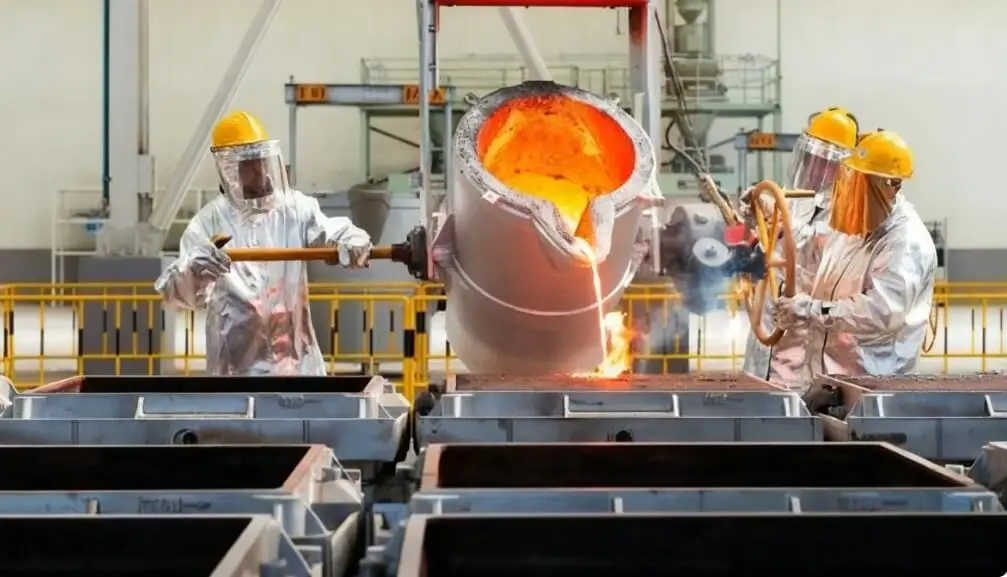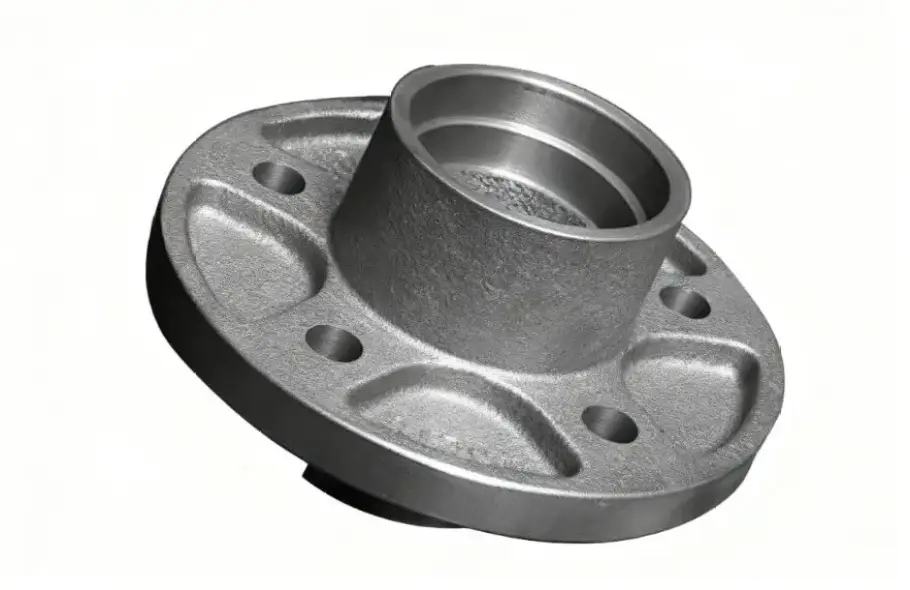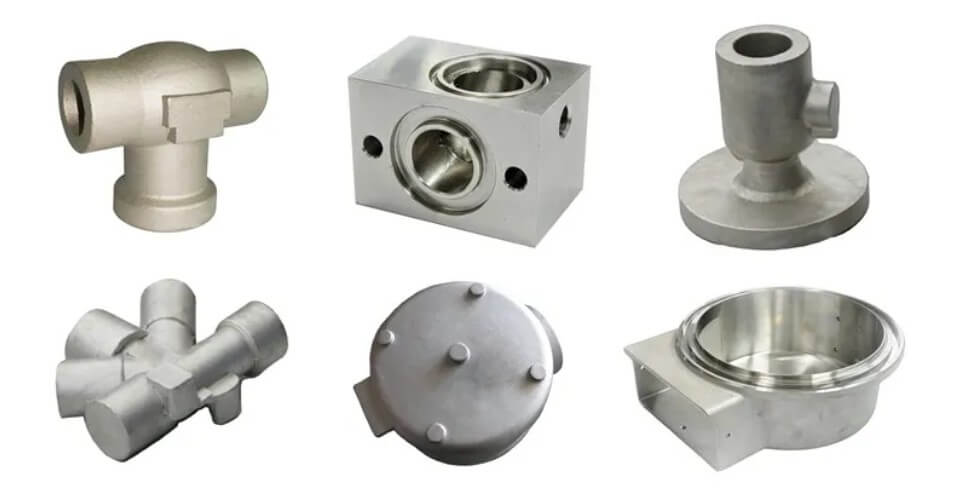What is a steel casting? Production and Applications
Steel is an indispensable foundational material in modern industrial manufacturing. Steel casting uses molten steel as the primary raw material, smelting and casting it to create complex, high-strength components. Whether in construction machinery, energy equipment, or transportation, steel castings play a vital role in supporting and bearing critical parts.
Table of Contents
1.What is cast steel?
Steel casting involves pouring molten steel into a mold, allowing it to cool and solidify into the desired shape. Unlike forging or cutting, this process involves “liquid forming,” making it suitable for producing parts with complex shapes and varying wall thicknesses.
Compared to iron, steel has a higher melting point and lower fluidity, resulting in more stringent process requirements for steel casting. The chemical composition and temperature must be precisely controlled during smelting to avoid defects such as porosity, cracks, and structural inhomogeneities.
The steel casting process generally includes: mold making → molten steel → pouring → cooling and solidification → demolding → post-processing (such as heat treatment, machining, and polishing).
Currently, steel castings are widely used in industries such as machinery manufacturing, mining equipment, energy and chemical engineering, automobiles, ships, aviation, and construction engineering. They are used to manufacture key components such as pump casings, valve bodies, gears, brackets, connecting rods, turbines, and axles.
2.Why Choose Steel for Casting?
The most fundamental reason for choosing steel for casting is that it offers a balance of strength, toughness, and machinability, meeting the demands of complex shapes and high performance.
The key characteristics of steel castings include:
- High Strength: Steel castings can withstand significant mechanical stress, making them an ideal material for structural and pressure-bearing components.
- Good Hardness: After heat treatment, the hardness of steel castings can be significantly increased, making them resistant to impact and wear.
- High Ductility: They exhibit excellent plasticity and deformation properties, making them less susceptible to brittle fracture.
- Excellent Wear Resistance: They are suitable for mechanical components subject to friction and wear, such as gears and liners.
- Corrosion Resistance: Stainless steel castings exhibit excellent corrosion resistance in humid or chemical environments.
- Good Machinability: Despite their high hardness, some steels can still be machined, allowing for the production of parts requiring high dimensional accuracy.

3.Why Use Steel Castings?
Steel castings are chosen because they offer a combination of high strength, toughness, and design flexibility. By adjusting the steel’s chemical composition, different properties can be achieved, and the casting process allows for the production of large, complex, and highly coherent components.
These steel castings can withstand heavy loads and impacts while ensuring structural reliability, making them an ideal choice for a variety of large-scale projects.
4.What are the four types of steel?
There are many classifications of steel, but a common approach is to categorize steel into four main groups: carbon steel, alloy steel, stainless steel, and tool steel.
Carbon Steel
Carbon steel is primarily composed of iron and carbon, typically containing less than approximately 2% carbon. It is categorized by carbon content into low-carbon steel, medium-carbon steel, and high-carbon steel. Carbon steel offers good machinability and cost advantages, and is commonly used in building structures, piping, and general machinery parts.
Alloy Steel
Alloy steel is an iron-carbon alloy with alloying elements such as nickel, chromium, molybdenum, and vanadium added to improve its strength, wear resistance, toughness, or corrosion resistance. Cast alloy steel is commonly used in automotive parts, shafts, gears, and various structural components, suitable for withstanding high loads or special working conditions.
Stainless Steel
Stainless steel contains a high proportion of chromium (typically ≥10.5%), which provides excellent corrosion resistance in humid or corrosive environments. It is widely used in applications requiring corrosion resistance, such as kitchenware, chemical equipment, architectural finishes, and medical devices.
Tool Steel
Tool steel contains a high proportion of alloying elements such as tungsten, molybdenum, vanadium, and chromium, and exhibits excellent heat resistance, wear resistance, and high hardness. It is suitable for manufacturing knives, dies, stamping tools, and cutting tools, and excels in precision machining and high-intensity working conditions.
5.Steel Casting Grades
Different types of steel are suitable for different applications. The casting requirements determine the steel grade. The following are some commonly used steel grades:
ASTM A27
This grade specification was developed for carbon steel castings. ASTM A27 is primarily used for general applications.
ASTM A216
ASTM A216 is a cast alloy composed of iron and carbon. Its properties include corrosion resistance, heat resistance, and wear resistance. It is often used in applications requiring high strength. It is also a suitable grade for applications requiring welding.
ASTM A352
ASTM A352 grade steel castings are commonly used for pressure-containing components such as valves, flanges, and fittings. This grade requires heat treatment.
ASTM A487
This grade of steel castings is suitable for use in the chemical and petrochemical industries. It offers high strength and corrosion resistance.
ASTM A148
This is a high-strength steel casting primarily used for structural applications, such as in the construction and industrial equipment industries.
Other types of steel casting grades include:
- ASTM A732
- ASTM A743
- ASTM A744
- ASTM A890
6.Four casting processes for steel castings
(1) Sand casting
Sand casting is the most commonly used steel casting method. Sand is used to make a mold shell, and molten steel is poured and solidified at high temperature. Because sand molds can be flexibly designed and can withstand the high melting point and slow cooling rate of steel, they are particularly suitable for the production of medium and large complex structural parts, such as machine tool beds, pump bodies and gearbox housings.
The advantages of sand casting are low mold cost and strong adaptability. It is especially suitable for small and medium batch production, and can effectively reduce casting defects through reasonable pouring system and exhaust design.

(2) Investment casting
Investment casting (lost wax casting) uses a wax mold to make a mold shell, and then pours molten steel to replace the wax mold position and solidify, which can achieve extremely high dimensional accuracy and surface finish. This method is particularly suitable for complex geometric shapes and thin-walled parts, and can meet the stringent requirements of high-performance steel castings for density and mechanical properties.
Typical applications include small precision transmission parts, gears, pump wheels and valve bodies in the automotive and aviation fields. Investment casting makes castings complex in shape and requires almost no secondary processing through precise mold control, which improves production efficiency.
(3) Die casting
Although the high melting point of steel limits the large-scale application of traditional die casting, high-pressure die-cast steel castings still have advantages in the production of small, high-precision parts. Die casting uses high-pressure and rapid injection of molten steel into the metal cavity to achieve rapid solidification, giving the castings excellent density and surface quality, which is very suitable for mass-produced parts such as small transmission parts, valve bodies and pump housings.
Steel castings produced by die casting not only reduce the amount of machining, but also ensure dimensional accuracy and internal structure density.
(4) Centrifugal casting
Centrifugal casting uses a rotating core to evenly distribute the molten steel in the mold cavity. The centrifugal force causes the molten steel to solidify close to the mold wall, thereby significantly reducing pores and inclusions and ensuring the internal density of the casting.
This method is particularly suitable for annular or shaft parts, such as sleeves, rollers and wheel parts, and is especially suitable for thick-walled or high-load-bearing annular components. Centrifugal casting not only improves the mechanical properties of the casting, but also saves materials and improves the overall casting quality.
7. Production process of steel castings
The production process of steel castings mainly includes the following steps:
(1) Raw material preparation
Scrap steel, alloy elements and internal scrap steel are classified and graded and then mixed in proportion. The mixing process must strictly control the composition so that molten steel that meets the design requirements can be obtained by smelting.
(2) Melting
- Electric arc furnace melting: Graphite electrodes are used to generate high temperatures to melt scrap steel and alloys, while impurities and dissolved gases are removed by refined oxygen. Electric arc furnaces can accurately control temperature and chemical composition and are the core equipment for producing large quantities of steel castings.
- Induction furnace melting: Steel is heated by electromagnetic induction, with high efficiency and low material loss. It is suitable for producing clean steel or high-alloy steel, but its refining capacity is slightly lower than that of electric arc furnaces.

(3) Refining and composition adjustment
During the melting process, oxygen is injected or chemical additives are used to remove slag, control the gas content, and adjust the alloy composition according to the analysis results of the charge to ensure that the molten steel meets the design requirements.
(4) Casting
The molten steel is transported to the casting mold through the ladle and solidified by sand mold, investment mold, die casting or centrifugal method to form the required casting. Before pouring, the quality of the molten steel can be further improved by measures such as slag removal and deoxidation.
(5) Heat treatment
After the casting solidifies, it needs to be heat treated to improve the mechanical properties and internal structure. Common methods include:
- Annealing: Slow cooling after heating to improve ductility and eliminate internal stress.
- Normalizing: Air cooling to improve strength and toughness.
- Quenching and tempering: Rapid cooling followed by tempering to achieve a balance between hardness and toughness.
8.Complete inspection methods for steel castings
In order to ensure the quality and reliability of steel castings, their dimensions, surface condition, internal integrity, chemical composition and mechanical properties must be fully inspected. The main methods include the following aspects:
(1) Dimensional accuracy inspection
Check whether the dimensions of the casting meet the design tolerances, including machining allowances. For castings with more complex internal dimensions, it may be necessary to cut samples through destructive testing to measure internal features to ensure that the parts meet the design requirements.
(2) Surface finish inspection
Casting surface inspection is used to detect defects that are difficult to detect with the naked eye, such as small cracks, pores or sand holes. Surface quality is affected by factors such as mold type, molding sand, mold coating, casting weight and cleaning method. Therefore, inspecting surface finish is an important part of evaluating the aesthetics and initial quality of castings.
(3) Internal integrity inspection
Castings may have defects such as pores, inclusions and shrinkage cavities during the solidification process:
- Porosity: bubbles with smooth interior, mostly caused by incomplete gas escape.
- Inclusions: Non-metallic or metallic impurities mixed into the molten steel, which may come from the molding sand, core or molten steel.
- Shrinkage: Low-density areas formed by insufficient feeding during the solidification of the material, with a rough surface and crystalline appearance.
(4) Chemical composition testing
- Furnace analysis and thermal analysis: Samples are taken to analyze the chemical composition of the molten steel before melting or pouring. If insufficient or deviations in alloying elements are found, they can be adjusted in the furnace or ladle in a timely manner.
- Product analysis: After the casting is cast, the individual pieces are analyzed to verify whether the chemical composition meets the specifications. Since element oxidation or segregation may occur during the pouring process, product analysis can supplement the results of the furnace analysis to ensure that the quality of each casting meets the requirements.
(5) Mechanical property testing
- Destructive testing: Tensile, bending or impact tests are performed on the casting samples to evaluate the material quality by observing the changes in internal structure and properties. Although this method can directly reveal the condition of the sample, it cannot represent all castings.
- Non-destructive testing: Using ultrasonic, radiographic, magnetic particle or penetrant methods, the castings are inspected for internal and surface defects without damaging them. Castings that pass the test can be put into use directly.
9.Application fields of steel castings
(1) Transportation / Automobile / Railway / Heavy vehicles
Steel castings can be used for engine cylinders, transmission housings, differentials, axles, wheels, frame connectors, etc. Due to their strong load-bearing capacity, wear resistance, and good formability, they are suitable for manufacturing complex structural parts.
(2) Engineering machinery / Construction equipment / Mining equipment
In excavators, bulldozers, cranes, mine cars, crushers, conveying equipment, etc., steel castings are used to manufacture frames, housings, connecting rods, assembly brackets and other components, playing the role of high strength, impact resistance, and wear resistance.
(3) Pumps, valves and fluid equipment
In the chemical, petrochemical, metallurgical, water treatment, power and other industries, they are used to manufacture pump bodies, valve bodies, flanges, pump housings, regulator components, etc. Steel castings can withstand high pressure, high temperature, and corrosive environments, and casting is more economical than machining when the internal structure is complex.

(4) Oil, gas and marine engineering
Steel castings are often used to ensure strength and durability in oil drilling equipment, oil well equipment, offshore platform facilities, node joints, pipe flanges, wellhead devices, etc.
(5) Heavy machinery/electricity/mining/metallurgical equipment
Such as rolling mill rolls, rolling mill frames, press bodies, casting equipment, wind turbine brackets, etc. Steel castings can withstand high loads and high fatigue conditions in these equipment.
(6) Military/Aerospace/Rail transportation
Steel castings are also used for parts with complex structures that require high strength and reliability (such as ship outfitting parts, aircraft structural parts, guide rails, locomotive parts, etc.).
(7) General engineering/heavy industry
Steel castings are also widely used in general machinery, transmission devices, reducer housings, gear shafts, couplings and other fields.
(8) Municipal/Infrastructure/Public Facilities
Although steel castings are less common than cast iron in the municipal sector, they are also used in bridge structures, brackets, column connections, heavy-load foundations, and other applications.
Choose LVXUN for your steel casting project.
Choosing LVXUN ensures high-quality steel castings. Our company boasts advanced melting and casting equipment, covering a variety of casting processes, including investment casting and die casting, enabling us to flexibly meet the production needs of complex shapes and large and medium-sized castings.
Through rigorous composition control, pouring management, and cooling processes, we ensure that each casting possesses a dense structure and stable mechanical properties. Furthermore, our comprehensive heat treatment and testing systems ensure that our products meet stringent requirements for dimensional accuracy, surface quality, and internal integrity, providing solid material support for critical components in key industries.

10.Summary
The key to manufacturing steel castings lies in ensuring the purity and accurate composition of the molten steel during the melting stage, followed by the use of appropriate casting processes for pouring and solidification. These castings are widely used in critical load-bearing applications in machinery, energy, transportation, and other industries, ensuring reliable operation under complex operating conditions.
FAQ:
What are the advantages of steel castings?
They offer high strength, excellent wear resistance, and corrosion resistance, making them suitable for withstanding heavy mechanical loads.
What are the surface treatment methods for steel castings?
Common surface treatment methods include sandblasting, spraying, and heat treatment to improve the corrosion resistance and aesthetics of castings.
How to choose the right steel casting supplier?
You should consider factors such as the supplier’s technical capabilities, production equipment, quality control system, delivery capabilities, and after-sales service.




